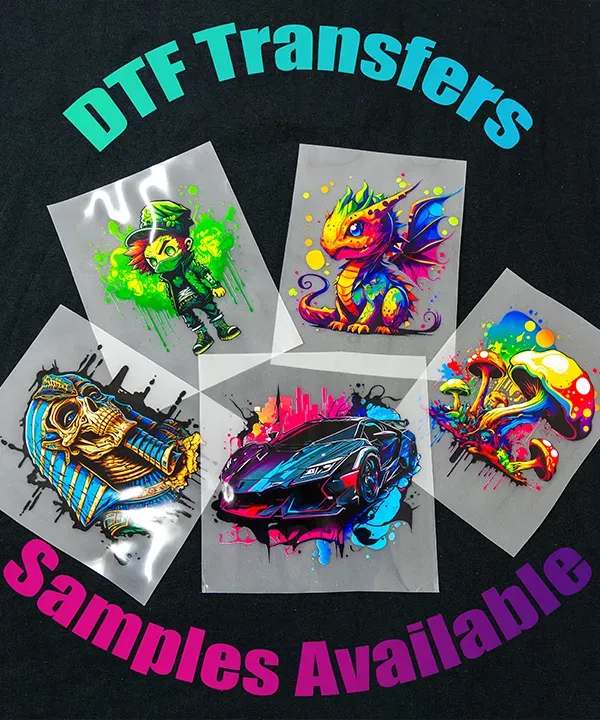DTF transfer, or Direct-to-Film transfer technology, is revolutionizing the custom apparel industry with its innovative approach to garment printing. This advanced printing technique allows for the application of vibrant designs on various fabric types, making it an ideal choice for businesses wishing to create high-quality custom apparel. The versatility of DTF transfer extends to the sizes of prints it can produce, accommodating everything from small logos to large graphic designs. As printing techniques evolve, utilizing a heat press for DTF can significantly enhance the durability and flexibility of these prints. In this guide, we will delve into the intricacies of DTF transfer technology, offering insights into materials, equipment, and the best practices for achieving optimal results with this method.
Also known as Direct-to-Film printing, DTF transfer represents a cutting-edge solution for graphic applications on textiles. This technique is gaining traction due to its ability to produce stunning visuals that are both resilient and adaptable, making it perfect for personalized clothing and promotional items. With a focus on precise film printing and effective heat application, DTF methods enable a range of designs tailored to specific garment needs. The diversity in DTF transfer sizes accommodates the unique demands of custom apparel, ensuring that every creation—from simple graphics to elaborate motifs—can come to life beautifully. Through its innovative processes, DTF transfer technology fosters creativity in textile printing, catering to a growing market that prioritizes both quality and customization.
Understanding DTF Transfer Technology
DTF transfer technology represents a significant evolution in garment printing, leveraging water-based inks and a unique transfer film to create stunning designs. This method begins with the creation of high-quality prints on a specialized film that serves as a transfer medium. Once printed, the film is coated with an adhesive powder that, when heated, bonds the print securely to the fabric. This innovative technique results in bright, long-lasting designs that maintain their vibrancy through countless washes, making it a perfect solution for custom apparel businesses seeking durability alongside aesthetic appeal.
Notably, DTF transfer is distinguished from other printing techniques such as Direct-to-Garment (DTG) and heat transfer vinyl (HTV). While DTG printing applies ink directly to the garment, DTF allows for more detailed prints on a wider range of fabrics, including those that may not typically accept ink well. Moreover, the adhesive used in DTF enhances the adhesion of ink to the fabric, thus reducing the chances of cracking or peeling over time. As a result, DTF transfer technology stands as a preferred choice for many businesses focusing on high-quality custom designs.
Diverse Sizes for DTF Transfers
One of the most compelling features of DTF transfer technology is its versatility in size adaptability. Whether you’re designing small logos for business shirts or large graphics for sports uniforms, DTF technology allows for a broad range of print sizes. This flexibility is crucial for businesses that cater to diverse customer needs, allowing them to create personalized apparel that suits individual preferences, promotional campaigns, and event merchandising.
However, the size of the DTF transfers also affects the application process. Larger prints may require a specific heat press configuration and garment type to ensure proper adherence and appearance. It’s essential to understand how different sizes may influence the final product’s look in order for businesses to effectively meet their customers’ expectations. For instance, intricate designs might work better in compact sizes to maintain detail, while large images can convey bold branding effectively. Therefore, understanding size variability is critical for leveraging the full potential of DTF transfers in custom apparel.
Essential Materials for DTF Transfers
To successfully execute a DTF transfer, certain materials and equipment are indispensable. First and foremost is the DTF printer, specifically designed for high-resolution printing on transfer films. This printer uses specialized water-based inks that ensure vibrant colors and a high-quality finish. Additionally, the transfer films themselves play a crucial role in determining the print’s saturation and long-term durability, so choosing a reliable supplier is essential for consistent results.
Furthermore, adhesive powder is another vital component in DTF transfers. This powder fuses the ink from the film to the fabric during the heat application process, creating a strong bond that withstands washing and wearing. Lastly, a reliable heat press is key to achieving optimal results; it must provide even heat and pressure across the transfer area for the duration specified in the application instructions. Without the right materials and equipment, the quality of DTF transfers can suffer, which can impact customer satisfaction and brand reputation.
Exploring Advancements in DTF Transfer Technology
The landscape of DTF transfer technology is continually evolving, thanks to ongoing advancements aimed at enhancing performance and efficiency. Recent improvements in ink formulations have resulted in products with superior adhesion qualities and increased resistance to fading. This means that prints can withstand more washes and wear, appealing to businesses looking for a lasting solution for their custom apparel needs.
Another significant upgrade comes from the design of modern heat presses specifically tailored for DTF transfers. These machines allow for greater adaptability across various garment sizes and types, which is incredibly beneficial for businesses that work with diverse fabric compositions. Innovations in production speed are also noteworthy; companies can now produce high-quality prints at a much faster rate, helping them to meet growing consumer demands without sacrificing print quality.
Common Applications for DTF Transfers
DTF transfers have found a wider application in the world of custom apparel, largely due to their versatility and ease of use. Sports uniforms are a primary market for DTF technology, as athletes require durable gear that can handle the rigor of frequent laundering while still showcasing vibrant custom designs. Teams appreciate the flexible nature of DTF, which allows them to add intricate logos or player numbers seamlessly, ensuring high visibility and aesthetic appeal.
Moreover, DTF transfers are increasingly popular in promotional apparel, such as merchandise for events or marketing campaigns. Businesses can produce intricate designs that resonate with their branding without the long lead times often associated with traditional screen printing methods. The growing trend of personalized clothing, including custom shirts for weddings or unique apparel for parties, has also seen significant engagement with DTF technology. This flexibility enables businesses to tap into niche markets and address specific client requests effectively.
The Future of DTF in Custom Apparel
As DTF transfer technology continues to gain traction, its future within the custom apparel landscape looks promising. The ongoing demand for high-quality, durable prints means that businesses adopting this technique can expect a competitive edge in a saturated market. With consumers increasingly seeking customized products, DTF provides an excellent avenue for brands to differentiate themselves by offering unique designs tailored to individual needs.
Moreover, as advancements in DTF technology continue to emerge, businesses will have access to improved materials, more efficient processes, and innovative designs. These enhancements will not only simplify the production of custom apparel but will also allow for the exploration of new design possibilities. Consequently, staying up to date with industry advancements and adopting new technologies will be key for brands aiming to harness DTF effectively in their product offerings.
Frequently Asked Questions
What is DTF transfer technology and how does it work?
DTF transfer technology, or Direct-to-Film transfer, is a modern printing technique that prints designs onto a specialized film. This film is coated with a powdered adhesive, which allows the design to transfer onto fabric when heat is applied using a heat press designed for DTF. The result is vibrant, durable prints that can withstand multiple washes.
What are the different DTF transfer sizes available for custom apparel?
DTF transfer sizes can vary significantly depending on the garment type and design requirements. Common sizes range from small logos suitable for t-shirts to large scale prints for hoodies or sports uniforms. Customization is key, allowing businesses to cater to specific client preferences effectively.
What materials are necessary for effective DTF transfer printing?
To produce effective DTF transfers, essential materials include a DTF printer capable of handling water-based inks, transfer films specifically designed for DTF applications, adhesive powder that bonds the print to the fabric, and a quality heat press for applying the transfer. Ensuring compatibility of these materials is vital for achieving optimal print quality.
What makes DTF transfer technology advantageous for custom apparel?
DTF transfer technology offers several advantages for custom apparel, including its versatility across different fabrics, ability to produce detailed designs, and impressive wash resistance. Additionally, it allows for quick production times, making it ideal for businesses seeking to deliver custom products efficiently.
How do advancements in heat press technology impact DTF transfers?
Recent advancements in heat press technology have greatly improved the DTF transfer process. New heat presses are designed to accommodate various garment sizes and provide more consistent heat application, essential for achieving high-quality transfers. This results in better adhesion and overall print quality, enhancing the durability of custom apparel.
In what common applications is DTF transfer technology utilized?
DTF transfer technology is widely utilized in several applications such as sports uniforms, promotional apparel, and personalized clothing. Its capacity for intricate designs makes it especially popular for creating custom items for events, teams, and individual celebrations, allowing for high-quality prints on various fabric types.
| Key Point | Details |
|---|---|
| Introduction to DTF Transfer | DTF (Direct-to-Film) is a versatile and high-quality printing technology used for custom apparel. |
| What is DTF Transfer? | A printing method where designs are printed on a special film, coated with adhesive powder for transfer onto fabric. |
| Size Variability in DTF Transfers | DTF can accommodate various sizes for different applications, from logos to large designs on athletic wear. |
| Key Materials and Equipment | Includes DTF printers, transfer films, adhesive powder, and heat presses for optimal print quality. |
| Advancements in DTF Technology | Improvements in ink formulations, heat press designs, and production speed enhance print quality and efficiency. |
| Common Applications of DTF Transfers | Used for sports uniforms, promotional apparel, and personalized clothing due to versatility and durability. |
Summary
DTF transfer technology is rapidly revolutionizing the custom apparel industry, making it a must-know topic for businesses and creators alike. This innovative process allows for vibrant and durable designs to be printed on various types of fabrics, offering unparalleled flexibility in terms of size and application. With advancements in technology enhancing the quality and efficiency of DTF transfers, it’s clear that this method meets a growing demand for personalization and quality in garment printing. Businesses that leverage DTF transfer techniques can significantly enhance their product offerings, engaging customers with high-quality, customized apparel that stands out in the competitive market.


